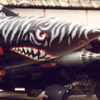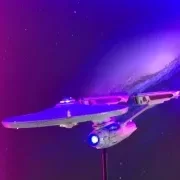Search the Community
Showing results for tags 'Kawasaki'.
-
source: http://www.hlj.com/product/DYS50075/Air 1/72 Kawasaki T-4 Blue Impulse by Doyusha Their Blue Impulse Sabre and other 1/72 kits are reboxed from Hobby Boss but this render looks like new tool. http://www.doyusha-model.com/ http://www.doyusha-model.com/hs_new_3.html
-
I bought this kit last year however looking at the exhaust downpipes, the way they were attached to the sprue gate it was obvious that the chrome finish would be ruined. So I decided to wait until I could get hold of some Alclad chrome. I have never used Alclad before and so I had to experiment a few times to get a decent finish, also the petrol cap had been plated with a silver aluminium type finish instead of chrome, so I had to redo that with Alclad as well and also the rear grab rail. The wheels had chrome rims which were ok but also had the spokes chromed which was wrong for the look of the model as they should be zinc plated so I brushed painted Stynylrez black primer over the spokes followed with some Vallejo metallic semi matte aluminium to give the effect of zinc spokes. Also the box art showed a real bike not any images of the model, I knew the model would not look as realistic unless I super detailed it. I used a 2K clear lacquer over the paint work, the paint is actually mixed by myself from a match that I sprayed a few years ago on a Z1A which was very similar. The tail decal went on ok however the tank decal required cutting to conform to the shape of the tank. I was not happy with this so I did put the decals on but they wrinkled a little so I 2K clear coated them then flatted the tank and resprayed the colours on with my airbrush using Tamiya 2mm curved masking tape which was perfect for this job. I was just finishing the build when I had major problems fitting the headlight shell and the front mudguard, basically both seemed a little too wide for the forks. Then I found that the headlamp bottom bracket that clamps around the forks just started to brake as well as the fork tubes broke so I had a major rebuild to perform but I got there in the end. Also the center stand broke so I left it on the side stand. It's a great kit but the plastic is a bit brittle.
-
Aoshima is to release a new 1/72nd Kawasaki Ki-100II Type 5 kit - ref.008706 N°9 Source: http://www.aoshima-bk.co.jp/english/News/2014-7.jpg V.P.
-
RS Models is to release a 1/72nd Kawasaki Ki-61 I Hei - short nose variant - kit - ref.92180 Source: http://rsmodels.cz/cs/modely-letadel/plastikove-modely/1-72/92180/ki-61-i-hei V.P.
-
Foxone Design Studio (http://foxonemodel.fc2web.com/hobby.htm) has just released a 1/144th Kawasaki P-1 3D print acrylic resin kit - ref. A061 Sources: http://foxonemodel.fc2web.com/original/lineup2.html#modal-p061 http://foxonemodel.fc2web.com/original/original.html http://foxone2.blog53.fc2.com/blog-category-97.html http://foxonemodel.fc2web.com/air_gallery/P1/144p1/144p1.html - ref. A114 http://foxonemodel.fc2web.com/original/lineup.html#modal-p114 - ref. A130 http://foxonemodel.fc2web.com/original/lineup.html#modal-p130 V.P.
- 14 replies
-
- 2
-

-
- Foxone Design Studio
- Kawasaki
-
(and 1 more)
Tagged with:
-
Kawasaki P-1. Pics thanks to Ken.
-
After the Ki-61 I Tei (http://rsmodels.cz/en/modely-letadel/plastikove-modely/1-72/92145/ki-61-i-tei & http://rsmodels.cz/en/modely-letadel/plastikove-modely/1-72/92143/ki-61-i-tei), Hei (http://www.britmodeller.com/forums/index.php?/topic/234982068-172-kawasaki-ki-61-1-hei-new-variant-by-rs-models-released/) and Ki-61 II Kai (http://rsmodels.cz/en/modely-letadel/plastikove-modely/1-72/92104/ki-61-ii-kai-with-bubble-canopy), RS Models is to release a 1/72nd Kawasaki Ki-61 I Otsu kit - ref.92179 Source: http://rsmodels.cz/en/modely-letadel/plastikove-modely/1-72/92179/ki-61-i-otsu Box art V.P.
-
I actually finished a model and it only took me two months... I present my first motorcycle model, hopefully not the last. I hope you like it. There are no doubt many things that could have been better, but overall I'm pretty happy with how it turned out. One of the flame motif decals is missing (thanks to a masking incident) but a replacement sheet is one the way. It's built out-of-the-box and finished in Tamiya Spray, Tamiya Acrylics and Alclad metallics. I used Alclad Aqua Gloss to seal the decals, but to be honest I didn't really get on with it and the finish is not as glossy as it might have been. Kawasaki Ninja ZX-14 Special Colour Edition by Caution Wake Turbulence, on Flickr Kawasaki Ninja ZX-14 Special Colour Edition by Caution Wake Turbulence, on Flickr Kawasaki Ninja ZX-14 Special Colour Edition by Caution Wake Turbulence, on Flickr Kawasaki Ninja ZX-14 Special Colour Edition by Caution Wake Turbulence, on Flickr Kawasaki Ninja ZX-14 Special Colour Edition by Caution Wake Turbulence, on Flickr Thanks for looking! I'll add a few close-ups later. The build thread is here. Cheers, Andrew
- 11 replies
-
- 8
-

-
My first foray into the world of bike kits.... I am completely ignorant about bikes in the real world - my bike only goes as fast as I can pedal it! So, here's the kit: Tamiya Kawasaki Ninja ZX-14 Box by Caution Wake Turbulence, on Flickr I've decided to go for the white scheme above. So far, I've assembled and primed the engine block and assembled parts of the frame and the exhaust. Overall, it seems to be a well moulded and well engineered kit, although the plastic does seem a little hard and brittle and needs a little extra care when cleaning up. I've stripped all the chrome off the exhaust sprue, as I want to have a go with the Alclad high shine chrome finish, which I haven't used before. I'll be using a mixture of Tamiya acrylics/sprays, Alclads and possibly some of the Mr Hobby metallic finishes. More photos to follow. Cheers, Andrew
- 47 replies
-
- Special Colour Edition
- Tamiya
- (and 4 more)
-
Hi Everyone, Here is my 3rd completed build of the weekend. It is the Tamiya 1/12 Kawasaki ZX-14 Ninja Special Edition. Painted by hand with Tamiya X-1 Black and X-7 Red. The decals went a lot better with this than my Hayabusa build. Anyway here are the photos. Look out for another bike build in the future, maybe even the alternate colour scheme ZX-14. ATB, Rick
-
Hi Everyone, This will be my first project of 2015, the Tamiya 1/12 Kawasaki Ninja ZX-14 Special Colour Edition motorcycle. I am struggling to decide which colour version of the bike to do. I thought maybe a poll would be the way to go. Please select the option you prefer. Version 1 Version 2 I personally like Version 2, however am still unsure which version to go for. Look forward to seeing the responses. Will get the sprue shots of the kit taken soon. Cheers, Rick
-
This is another kit that is being sacrificed so I can learn to airbrush. I started it as I am waiting for my latest airbrush disaster (Neptune Build) to finish drying so I can attempt to fix/repair the damage I have done through means I am not sure of. So, another fatted calf off to my painting slaughter house. It is the 1/32 Hasegawa Kawasaki Ki-61-1 Otsu (Tony) Shinten Seikutai. Whew, try and say that quickly. I chose this kit as it should be an easy build and it will be an experiment with Japanese camo schemes before I attack my ZM Raiden that is patiently waiting to be painted. If I can get the scheme I am doing down right, I will tackle the Raiden next. If you check some of my more recent WIPs you will find I consider airbrushing a dark art that is always trying to defeat me (and it succeeds most of the time) This will be an OOB as the main point is to get to the airbrush camo stage. So here goes. . . I gave the cockpit parts a base coat of interior paint. While that dried, I painted the various interior detail parts while still on the sprue. When the base coat had dried, I glued the main instrument panel to the front bulkhead and applied the decal for the instruments. This photo reflects the decal is resisting conforming to the panel surface and I am coaxing into compliance. Resistance is futile. Next up, I install all the little pieces where they should go in the main cockpit parts to get ready to do the detail painting and weathering. I have also coaxed all the decals for instruments to conform to their respective surfaces. (Not a great talent I have, just Micro Set and Sol make me look like I know what I am doing.) I am going to let this dry overnight before I get down to detailing and weathering. As always, all comments welcome.
-
Kawasaki Ki-61 Type I-TEI, #5262, Chofu, April 1945, Pilot: 244th Senai commander Capt. Teruhiko Kobayashi (reserve a/c) Kit: Hasegawa (in the meantime clearly superseded by Fine Molds and RS Models) Photo-etched parts: Eduard Wheels with rubber tires: Equipage Decals: Life Like Decals “244th Sentai Pt.2” Built in 1997 and finished initially as that dubious "Shamrock Tony" much discussed around 2000. Partially repainted and completely re-decalled in 2004. Although the level of painting and weathering leaves something to be desired being obviously below that of my more recent models presented here and the exact colours might remain somewhat controversial, lot of corrections and extra detail (wheel wells,ventral radiator, drop tanks - just to mention a few...) were done and so I dare to present it to your attention...
- 10 replies
-
- 11
-

-
Aoshima (http://www.aoshima-bk.co.jp/) is to release in December 2013 and January 2014 two 1/72nd Kawasaki Ki-100 Type 5 variants - the Kou & the Otsu - ref.008096 & 008126. Source: https://www.facebook.com/Aoshima.Bunka.Kyozai.Co.Ltd/photos_stream Source: https://www.facebook.com/HobbyLinkJapan Source: http://www.aoshima-bk.co.jp/english/ProductDetails.aspx?code=00809 Also here http://www.dragonmodelsusa.com/dmlusa/prodd.asp?pid=AOS008096 http://www.dragonmodelsusa.com/dmlusa/prodd.asp?pid=AOS008126 V.P.
-
Kawasaki T-4 'Blue Impulse 2013' 1:72 Hasegawa - Limted Edition Double Kit Boxing Even though most would associate Kawasaki with the Motorcycles they make, Kawasaki are one of those mega Japanese companies which seem to make everything! They make Ships, Trains, Cars, Motorcycles Engines; and importantly for us Aircraft. The Kawasaki T-4 is know as an Intermediate Jet Trainer. It is used exclusively by the Japanese Air Self Defence Force. The JASDF realised in the late 1970s that they needed to replace their existing Jet Trainers (The Lockheed T-33 & Fuji T-1) with a single type. This aircraft was to be known as the MT-X programme. In 1981 Kawasaki was selected as the main contractor under this programme. It was planned to build 220 aircraft with an in-service date of 1988. Given the requirements of the programme for an advanced two seat trainer it is no shock that the final result looks very similar to other two seat trainers. In total 208 production aircraft were built along with 4 prototypes. Deliveries started in 1988 as per the plan! At least 5 of these aircraft were lost at Matsushima AB during the devastating Tsunami in 2011. Blue Impulse The most visible presence the T-4 makes is that it has been used since 1995 by the Blue Impulse, the Aerobatic Display Team of the Japanese Air Self Defence Force. The Blue Impulse Team were formed in 1960 Flying the then F-86 Sabre, in 1982 they transitioned to the Mitsubishi T-2; and then in 1995 to the Kawasaki T-4. The team currently fly seven T-4s, though only six display at one time. The team aircraft are painted blue and white following previous schemes. They are equipped with a smoke system which can generate white, red, blue and yellow smoke. The Kit The Hasegawa T-4 kit is the only current kit of the T-4 in 1:72 scale, the kit was tooled back in 1989 and has been steadily re-released ever since. This Double boxing has been released with markings for the 2013 Blue Impulse Aerobatic Display Team. Construction starts with the cockpit, you get a basic cockpit tub into which two seats and instrument panels are added along with the control columns. Decals are provided for the instrument panels and side consoles. After adding the cockpit, and the forward gear well the fuselage can be closed up.. The wings (traditional top & bottom construction) can then be joined to the fuselage along with the tail planes and intakes, once this is done the exhausts can be added along with the main and nose landing gear. Finally the modeller can decide to add external tanks if they wish. Blue Impulse aircraft have been seen displaying with and without these tanks. Decals The decals are the star of this re-boxing. Decals are provided to make any two of the Blue Impulse Team. Conclusion This is not a new tool by any means, but neither is it an ancient tooling that is crying out to be replaced. For this scale the detail included in the kit is sufficient for a great many of us, and for the T-4 it is the only game in town in this scale, with little likelihood of a new tooling, given that it is not widely used outside Japan. Overall I would recommend this kit. Review sample courtesy of UK distributors for
-
Kawasaki T-4 Blue Impulse 2013/2014 Hasegawa 1:48 Even though most would associate Kawasaki with the Motorcycles they make, Kawasaki are one of those mega Japanese companies which seem to make everything! They make Ships, Trains, Cars, Motorcycles Engines; and importantly for us Aircraft. The Kawasaki T-4 is know as an Intermediate Jet Trainer. It is used exclusively by the Japanese Air Self Defence Force. The JASDF realised in the late 1970s that they needed to replace their existing Jet Trainers (The Lockheed T-33 & Fuji T-1) with a single type. This aircraft was to be known as the MT-X programme. In 1981 Kawasaki was selected as the main contractor under this programme. It was planned to build 220 aircraft with an in-service date of 1988. Given the requirements of the programme for an advanced two seat trainer it is no shock that the final result looks very similar to other two seat trainers. In total 208 production aircraft were built along with 4 prototypes. Deliveries started in 1988 as per the plan! At least 5 of these aircraft were lost at Matsushima AB during the devastating Tsunami in 2011. Blue Impulse The most visible presence the T-4 makes is that it has been used since 1995 by the Blue Impulse Aerobatic Display Team of the Japanese Air Self Defence Force. The Blue Impulse Team were formed in 1960 Flying the then F-86 Sabre, in 1982 they transitioned to the Mitsubishi T-2; and then in 1995 to the Kawasaki T-4. The team fly seven T-4s though only six display at one time. The aircraft are painted blue and white following previous schemes. They are equipped with white, red, blue and yellow smoke systems. The Kit The T-4 kit has been around in various boxing from Hasegawa since the 1990s. The moulds have held up very well and all parts are very crisp with no signs of any flash. Construction starts as with most aircraft with the cockpit. Two pilot figures are provided and the kit representation of the Stencel S-III-S Ejection seats are very good, the seats contain 10 parts each. Decals are provided for the instrument panels and side consoles. Next up are the intake trunks and exhausts. The intake trunks are fairly deep and end at a engine fan part. The intakes consist of 6 parts each, the main intake trunking has a seam but I am not sure how much you will see of this. The exhaust consist of 4 parts with the last stage being one piece so there is no seam there. The cockpit is then installed inside the fuselage halves along with the exhausts and plastic grommets for the tail planes. The fuselage can then be joined up and the intake trunking parts added. Following this The wings are added, the modeller will need to decide if they are going to add the drop tanks and open the holes as needed. I have seen the Blue Impulse flying with and without tanks so it is up to the modeller to decide if they want them or not. The wings are fitted with large tabs which slot together inside the fuselage making this joint very strong. The large under fuselage insert is then added. Again a pair of plastic grommets needs to be added for the landing gear. Finally the landing gear and various fuselage intakes and bumps are added. Lastly the canopy can be fixed in the open or closed position. Canopy The canopy is very clear. On the main canopy however there is a centre line seam which the modeller will need to remove. Decals Decals are provided to make any of the team aircraft numbered 1 to 6 for the 2012 or 2013 Airshow seasons. The decals look glossy and in register. Some of the wing chevrons in blue for the top and white for the underside are provided though I am sure most will mask and paint these as not all of the blue is provided as decal and it will be difficult to match paint to the decal blue as you have to mix the paint colour. This shade of Blue Impluse Blue is not available direct unlike the T-2 colours which were available from Gunze. Conclusion Overall recomended for Japanese aircraft fans, Blue Impulse Fans or if you fancy building something different. Review sample courtesy of UK distributors for
-
Kawasaki Ki-45Kai Hei Toryu Manchurian Air Corps Hasegawa 1:48 In 1937 the Japanese Army issued a requirement for a two engine fighter. The specifications were for a fighter that could go 340 mph at 10,000', operate from 6,500' to 16,250', and cruise for 4 hours and 40 minutes at 220 mph. Mitsubishi and Nakajima also submitted designs as well, but the Nakajima was selected. Kawasaki submitted the Ki-38 which would later become the Ki-45. In January 1939 a prototype with two Bristol Mercury engines was first flown. Later aircraft had the Nakajima Ha-25 radials installed. The prototype didn't meet specifications mostly due to the engines. In late 1939 test flights were stopped while Kawasaki rectified the problems. This modified design became the Ki-45 KAI, with KAI meaning "modified. The Ki-45 was initially used as a long-range bomber escort. The 84th Independent Flight Wing (Dokuritsu Hikō Chutai) used them in June 1942 in attacks on Guilin, where they encountered, but were no match for Curtiss P-40s flown by the Flying Tigers. In September of the same year, they met P-40s over Hanoi with similar results. It became clear that the Ki-45 could not hold its own against single-engine fighters in aerial combat. It was subsequently deployed in several theaters in the roles of interception, attack (anti-ground as well as anti-shipping) and fleet defense. Its greatest strength turned out to be as an anti-bomber interceptor, as was the case of the Bf 110 in Europe. In New Guinea, the JAAF used the aircraft in an anti-ship role, where the Ki-45 was heavily armed with one 37 mm (1.46 in) and two 20 mm cannons and could carry two 250 kg (550 lb) bombs on hard points under the wings. 1,675 Ki-45s of all versions were produced during the war. By the spring of 1945, the advent of American carrier-based fighters and Iwo Jima-based P-51s escorting B-29s over the skies of Japan brought the Ki-45's career to an end. Three Ki-45s fell into communist Chinese hands after World War II. Unlike most captured Japanese aircraft that were employed in the training role, the three Ki-45s were assigned to the 1st Squadron of the Combat Flying Group in March 1949 and were used in combat missions. These aircraft were retired in the early 1950s. The Model This model has been re-issued a number of times now with differing decals as the Hasegawa way of doing things. That said it still looks a very nice kit. Inside the standard Hasegawa style top opening box, on which a pictorial representation of the aircraft in Manchurian Air Corps colours is depicted. On opening the box the modeller is confronted with several poly bags containing the seven sprues of grey styrene and one sprue of clear parts. The mouldings are very clean and flash free, with small moulding pips on some of the more complex parts, perhaps more worryingly there are quite a few on the clear parts. Admittedly they are on the canopy frames, but care should be taken when removing. There is very finely moulded recessed and raised detail where required and both the cockpit and undercarriage bays come pretty well detailed, although there is still plenty for modellers to add extra should they wish. The clear parts are nice and clear although a dip in Aqua Gloss or Future wouldnt go amiss. There are some ejector pin marks on the rear and centre canopies, which would be a problem if they werent mostly concealed by a coat of paint. The instructions, in a multi folded sheet are really clear to read, with the identification of parts in Japanese and English. The build begins with the two seat cockpit; the multi level floor of which includes spars for the wings is fitted out with the pilots seat, pilots and co-pilots instrument panels, side consoles, joystick, rudder pedals and rear bulkhead. The instrument panel and consoles have raised detail for those who like to paint their panels or decals for those who dont, in which case the raised detail has to be removed first. The fuselage sides are then detailed with internal panels for the rear cockpit and control boxes for the front. The completed cockpit is then sandwiched between the fuselage halves along with the co-pilots seat. The forward bulkhead is then added, along with the cannon trough on the belly of the aircraft. The modeller has the option of painting the rear ident light and the warning light on the fuselage top or removing the plastic and using the clear parts provided. The completed fuselage can now be put aside as the construction moves onto the engine nacelles and wings. The nacelles comprise of inner and outer halves, with the outer fronts separate. Internally they have a rear bulkhead and oil cooler exhausts fitted before closing up. The completed nacelles are then attached to the wings, once the upper and lower halves have been glued together. At this point the nose halves are also glued together and the underside clear part fitted. The fuselage, wing and nose sub-assemblies are now brought together, along with the single piece horizontal tailplanes to build the main aircraft structure. The port wing is fitted with the landing light glass and pitot probe. The engines are built up using the one piece cylinder bank, crankcase, oil cooler ring and the cowling halves. The engines are not particularly detailed and could do with tarting up a bit, but how much is up to the modeller, bearing in mind that not much will be visible once the cowlings are fitted. The complete assemblies are then fitted to the nacelles, but not before the three piece oil cooler intake and the two piece exhausts are attached to the front bulkhead of the nacelle. On the underside of the wings, between the nacelles, two fuel coolers are fitted, along with the cannon, with alternative muzzles, retractable foothold and signal light which are attached to the lower fuselage. Each main undercarriage is made up of the main legs, separate scissor links, two piece tyres, with separate inner and outer hubs, retraction jack and support arms. With these positioned in the nacelle bays the undercarriage doors can be attached. The tailwheel consisting of a one piece oleo/wheel arrangement and separate scissor link, is glued into place. The propellers have separate hubs and spinners and once assembled they can be attached to the prop shafts. The final stage of the build is the fitting of the gun sight, aerial mast and canopies, for which there are separate parts depending on whether the cockpits are to displayed open or closed. Decals The decals are provided for two aircraft, both of which were flown by the 3rd Squadron, Manchurian Air Corps. They are well printed, in good register and density. Conclusion Whilst this aircraft has be re-released a number of times, its still a good looking aircraft and the Manchurian insignia makes it look quite different. I havent tried for fit, but Im sure its pretty good as Ive not read of any problems when researching for this review. The detail may not be up to the latest releases, but theres more than enough for the average modeller. If anyone mentions the prices of recent releases by Hasegawa they will be taken outside and shot. Amerang Hasegawa Review sample courtesy of UK distributors for
-
East Anglian Air Ambulance G-OEMT, BK117C, pics by Angelo (HL-10)









